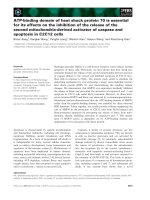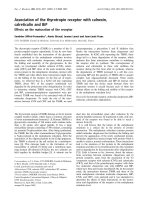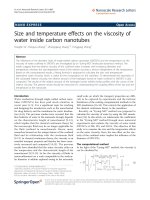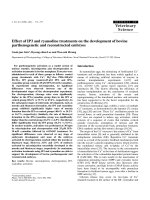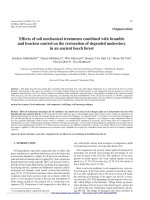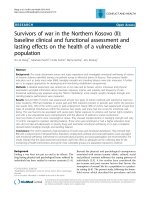Globalization and its effects on the development of educational service in Vietnam
Bạn đang xem bản rút gọn của tài liệu. Xem và tải ngay bản đầy đủ của tài liệu tại đây (659.88 KB, 63 trang )
Website: Email : Tel (: 0918.775.368
Foreword
1. Inevitability
Since 1986, Vietnam has been conducting a process of economic innovation . It
has been steadily opening its economy to be able to integrate into the global
marketplace more and more. During this time, the world in which we live has greatly
changed. The collapse of the Soviet Union was followed by the world fully
embracing, the form of government employed by the three economic superpowers:
the US, EU, and Japan.
The rapid development of technology has radically changed the face of global
economy. In particular, information technology and communication technology have
altered the face of the global economy, making it increasing rapidly. As proclaimed
by the title of a recent famous book “The World Is Flat”. International trade activities,
global investment activities and migration around the world are three remarkable
dimensions of today’s global activities. It is now so easy to trade with other countries,
even with particular individuals in other country; that the capital can now flow
throughout the world with ease. Today, individuals can easily visit every country on
Earth. We call this process “globalization”, we are now living in “ the globalization
age”.
In 2007, Vietnam joined in the World Trade Organization( WTO). This leads us to
believe in that Vietnam is inclined to increasingly participate in this “ flat world”.
This country of eighty million people is becoming a “vital” part of the global
economy. The deeper Vietnam takes part in the global economy, the greater the
impact of globalization on Vietnam becomes. Globalization affects every aspect of
Vietnam: Economy, Social, Culture, ...and even its education system. There is a
mutual correlation between education and globalization, reflecting how globalization
impacts education , and how education responds to globalization in turn.
Historically, education in Vietnam has always been very important; the Vietnamese
people have always cared deeply about this issue. The impact of globalization on
Page 1
Website: Email : Tel (: 0918.775.368
education in Vietnam is an issue of rising importance. Accordingly, I have conducted
research on “ Globalization and its effects on the development of educational
service in Vietnam”
2. Object and Field
We will consider three features of globalization: international trade, global
investment and migration.
Taking data from 1986 in Vietnam and from 1950 across the World.
3. Research Methodology
At first ,I will present a little research about how globalization affects the demand
and supply of education at both the micro and the macro level in some countries such
as Singapore, Brazil, and Korea, etc. I will then explore how globalization affects
Vietnam’s education, also at both the micro and the macro level. Finally I will try to
give suggestions for a better strategy for education services in Vietnam.
4. Table of Contents
I. Foreword
1. Inevitability
2.Objective
3.Object and field
4. Research Methodology
5.Table of Contents
II. The Main Content
Chapter I: Overview
1.1 Globalization
1.1.2 The impact of globalization
1.1.2.1 Positive impact
1.1.2.2 Negative impact
1.1.2.3 Impact on International Relations and International Integration Processes in
the World
1.2 Education Services
1.2.1 General knowledge
1.2.2Overview of education services in Vietnam
1.3 Education and globalization
Page 2
Website: Email : Tel (: 0918.775.368
1.3.1 Education and international trade
1.3.1.1 Education and exports at macro level
1.3.1.2 Education and global value chains
1.3.1.3 Education and offshoring services
1.3.1.4 Education and responding to trade
1.3.2 Education and the ability to attract private capital flows
1.3.2.1 Technical and engineering skills and manufacturing FDI
1.3.2.2 Centres of Excellence and attracting strategic asset seeking FDI
1.3.2.3 The effects of education on FDI at the sectoral level
1.3.2.4 Education and benefiting from FDI
1.3.3 Education and the probability of migration
1.3.3.1 permanent migration
1.3.3.2 temporary migration
1.3.3.3 Types of education
1.4 The effects of globalization on education
1.4.1 The effects of trade on education
1.4.1.1Trade and demand for education at macro level
1.4.1.2 Trade and supply of education at macro level
1.4.1.3Trade and education at the micro level
1.4.2 The effects of FDI on Education
1.4.2.1 Macro effects on demand for education
1.4.2.2.Macro effects of FDI on the supply of education
1.4.2.3 Micro effects on demand for education
1.4.2.4 Micro supply of education and training – voluntary contributions
1.4.2.5 Micro supply – vocational training
1.4.2.6 Micro supply – tertiary education
1.4.3 The effects of Migration on Education
1.4.3.1 Migration and the supply/loss in teacher capacity in the education sector
1.4.3.2 Macro effects of migration on education
1.4.3.3 Migration and private incentives to invest in human capital
1.4.3.4 Other effects of migration
Chapter II: Education services in Vietnam under the impact of globalization
2.1 The impact of international trade on education services in Vietnam
2.1.1 Trade and supply for education at macro level
Page 3
Website: Email : Tel (: 0918.775.368
2.1.2 Trade and supply for education at micro level
2.1.4 The impact of adhering to WTO on education service in Vietnam
2.1.4.1 The thought of education has changed
2.4.1.2 The impact of adhering to WTO on education service in Vietnam
2.2 The impact of FDI on the education service in Vietnam
2.2.1 Macro effects on demand for education
2.2.2 Macro effects on supply for education
2.2.3 Micro effects on supply for education
2.3 Education services in Vietnam under the impact of migration
2.4 Education system in Vietnam under the impact of globalization
2.4.1 Education services in Vietnam and international trade
2.4.2 Education in Vietnam and FDI
2.4.3 Education in Vietnam and migration
Chapter III: Strategy for developing education services in Vietnam in globalization.
3.1 Increasing the impact of education on international trade
3.1.1 developing education system to export education services
3.1.2 Education and training to adapt new global value chains
3.2 Education in Vietnam and the ability of attracting FDI
3.2.1 Attracting FDI into education services itself
3.2.2. Education system not only adapts to the need of skilled workers from FDI
companies but also create a well-known workforce for Vietnam to attract FDI.
3.3 Education and migration
3.3.1 Attracting Vietnamese people who are living are working at foreign countries
to dedicate Vietnam’s education development.
3.3.2 Attracting scientists all over the world coming to work and do research in
Vietnam.
3.4 public policies
3.4.1 Human resource development policies
3.4.2 investment policies
3.4.3 trade policies
3.4.4 migration policies
Page 4
Website: Email : Tel (: 0918.775.368
List of Acronyms and Abbreviations
BAT - -British American Tobacco Group
BP --British Petroleum
EPZ --Export Processing Zone
FDI --foreign direct investment
GATS --General Agreement on Trade in Services
GDP --gross domestic product
GVC --global value chain
HO --Heckscher-Ohlin
HRDF -- Human Resource Development Fund
MFA -- Multi Fibre Arrangement
MNE --multinational enterprise
OBM --original brand manufacturing
OEM --original equipment manufacturing
PSB --Productivity and Standards Board (Singapore)
PSDC --Penang Skills Development Centre (Malaysia)
R & D --research and development
SDF --Skills Development Fund (Singapore)
UNESCO-- United Nations Educational, Scientific and Cultural Organization
UK --United Kingdom
US --United States (of America)
WTO -- World Trade Organization
WB --World Bank
Page 5
Website: Email : Tel (: 0918.775.368
1.1Globalisation
1.1.1 Defining globalization
Globalization in this study refers to three economic features that increasingly link
countries together: trade in goods and services, FDI, and migration.
• Trade in goods and services: trade in goods and services has increased faster
than national incomes in almost all countries.
Source: IMF
Chart: Increasing World Trade
We consider two key processes driving this expansion in trade: increased
fragmentation and emergence of global value chains. The first significant feature of
the increase in trade over the past decades is fragmentation.
- Fragmentation: the fragmentation of production processes is also called
“vertical specialization” and is commonly referred to as the relocation of parts
of the production process from one country to another. Most of the attention
used to focus on fragmentation in the goods chain, but more recently attention
has also focused on fragmentation of services processes.
Page 6
Website: Email : Tel (: 0918.775.368
The second important feature in globalization recently is the emergence of global
value chains.
- Global value chains involve trade through networks of firms
across borders. A value chain includes the full range of activities
required to bring a product or service from conception, through the
intermediary phases of production( transformation and producer
services inputs), to delivery to final consumers and ultimate disposal
after use.
• FDI, FDI to developing countries has increased dramatically over the past
three decades. While most FDI is amongst developed countries, and most FDI to
developing countries is concentrated amongst a few such as China, Mexico, Brazil,
Malaysia...
Chart: Resource flows to developing countries from 1990 to 2005
Source: WB
1.1.2 The impact of globalization
1.1.2.1 Optimist impacts
Page 7
Website: Email : Tel (: 0918.775.368
o Expanding market, Fragmentation and global value chains are increasingly
sending products all over the world.
o Transfer of technology from developed countries to developing countries has
become easier.
o Information and transportation networks now cover the entire World.
o Fighting for peace, cooperation and development has become easier.
1.1.2.2 Negative impacts
o Developed countries continue to dominate the global economy
o The gap between rich and poor has increased across the world
o The global economy has become increasingly fragile.
o Negation in global trade has increased
1.1.2.3 Impact to international relations and international integration processes
across the world
o The world is moving towards an open-door policy
o Multilateral relations are playing an increasingly important role in
international relations
o Interdependence amongst national economies has increased
o In international relations, there have always existed two dimensions:
cooperation and competition.
1.2Education
1.2.1 General knowledge
There are several modes of acquiring human capabilities, such as education and
training. We will distinguish between schooling, vocational training and tertiary
education (UNESCO, 2003) in the national context, and foreign education in the
international context:
• Schooling. This includes primary and secondary education: primary or elementary
education is the first years of formal education generally beginning when children are
four to seven years of age. The division between primary and secondary is sometimes
difficult to make, but it often occurs at about twelve years of age. Primary education
aims to provide basic literacy and numeracy skills students and foundations in other
subjects. Secondary education follows after this.
Page 8
Website: Email : Tel (: 0918.775.368
• Vocational training/education. This includes skills training, particularly on-the-
job training.
• Tertiary education. This includes domestic higher education institutes.
• Foreign education. This includes students following tertiary education abroad or
people purchasing online distance learning from abroad, and can be distinguished
from tertiary education provided domestically
1.2.2 Overview of educational services in Vietnam
In the feudal period, the education system of Vietnam was strongly influenced by
the education feudal system of China. During the feudal-colonial France, education in
Vietnam is influenced by education feudal and colonial France.
From the revolution in August 1945 to 1975, education in the north of Vietnam is
influenced by the education system of the Soviet Union. During the same period,
education in the south of Vietnam was influenced by the American education system.
From 1975 to 1986, education in Vietnam was influenced by the Soviet education
system. From 1986 to the present, Vietnam has conducted the innovation education
program, along with the renovation of the whole country.
1.3 The effects of Globalization on Education
We will examine how the quantity, quality and type of human resources determine
how countries can participate in globalization. It can be hypothesized that productive
and competitive economies are more likely to participate successfully in globalization
than those economies that are not.
1.3.1 Education and the ability to trade
Education and skills development allow firms and people to take part in
globalization processes such as exports of processed goods and global value chains. It
is important to have a flexible education system in order to adjust to new trading
conditions (complementary policy for successful globalization): while more advanced
countries (especially East Asians) have been able to have an active national policy
stance to promote education for exports (Korea is the prime example) some poorer
countries have faced more difficulties adapting, probably due to less flexible
education systems.
Page 9
Website: Email : Tel (: 0918.775.368
1.3.1.1 Education and exports at the macro level
The HO( Heckscher- Ohlin) model- the main model employed by traditional trade
theorist to understand trade flows- predicts that natural resources and labor forces will
determine the comparative advantages of various nations, and thus lead to the
economic specialization in those countries. Africa is abundant in low-skilled labor
and land per person/worker and this determines its comparative advantage in
international trade. Land abundance and lack of skilled labor explain Africa’s
concentration on the export of unprocessed primary products. The econometric
analysis suggests that the low skill/land ratio explains the low ratio of manufactured
to primary exports in Africa relative to other groups of developing countries.
Wood and Mayer are specific on the level of education helpful for achieving more
exports. They argue that it is important to think about the appropriate mix of different
levels and types of education. On the one hand, there is the need to provide everyone
with good basic education, while on the other hand a minority needs to be equipped
with relevant advanced skills. They cite the example of growth of forestry exports in
Chile which was facilitated by the availability of forestry engineering graduates from
local universities.
There is less evidence of the effects of vocational training on exports. These effects
are likely to depend on the specifics of the training. Many developing countries
operate a levy on a firm’s payroll that can then be spent on approved training courses.
Skill upgrading may occur in this way. However, there is no guarantee that training
works for all, that quality is the same for each type of program, and that such training
is aimed at unskilled or just the skilled workers with sufficient education. In some
countries, training levies are voluntary and few graduates pass through approved
training courses. It is important to realize that there is a long tradition of training
institutes in Latin America and there may be more than in East Asia, where skill
upgrading has been faster and more appropriate (e.g. the Singapore SDF [Skill
Development Fund], and similar schemes in Malaysia),suggesting that the mere
existence of such institutes is not sufficient. Indeed many institutions do not appear to
Page 10
Website: Email : Tel (: 0918.775.368
provide appropriate training, although Chile may have improved the relevance of
human resource development to private sector needs recently
1.3.1.2 Education and global value chains
The literature on GVCs is increasing; It emphasizes the importance of relationships
amongst firms in a value chain. This literature would suggest that particular
(communication) skills are required to take part in such value chains. However there
is not much evidence regarding the role of education and skills in this process. Only a
few papers discuss skill requirements for participating in global value chains. We will
discuss value chains for clothing and commodities.
The structure of trade in clothing is changing. Clothing in the US and Northern
Europe is now dominated by a handful of retailers, leading to buyer-driven
commodity chains. Large and transnational manufacturers play a central role in
coordinating production networks in producer driven commodity chains, in a buyer-
driven commodity chain large retailers, however, branded marketers and branded
manufactures play an important role in coordinating and relocating production
networks, typically towards developing countries whose firms are contracted to
supply goods according to specification. A tiny handful of firms (retailers, branded
marketers/manufactures, etc.) determine where clothing is sourced . Some countries
have fared well under the buyer-driven system, with some Asian countries becoming
OEM (original equipment manufacturing) producers and/or OBM (original brand
manufacturing) producers. Such a transition requires a skilled workforce with
appropriate design and marketing skills. The newly industrialized economies in East
Asian became OEM producers partly through ‘triangle manufacturing’, whereby US
buyers place an order with East Asian NIEs, who in turn shift part of the production
to low-wage countries (China, Indonesia, Vietnam), and finished goods are shipped
directly from that country to the US under the US quota system (in operation until the
quotas of the MFA (Multi Fibre Arrangement) were phased out in 2005) which
applies to the exporting country . However, other countries are locked into the
upstream part of the production chain with few incentives (from actors lower and
Page 11
Website: Email : Tel (: 0918.775.368
further down the value chain) and few skills to upgrade to OEM production. It is thus
important to keep upgrading and acquiring new skills.
Similar issues play a role in commodity trade. In order to supply the major
importers of fruits, vegetables, coffee, cacao, tea and other commodities in the
developed markets, it is not sufficient to focus only on efficiency of individual
operations. It is now increasingly important to understand how individual operations
fit in the entire value chains. This requires good communication skill and methods as
well as entrepreneurship skills that can help operations to fit into the value chain. Te
Velde et al. (2005) discuss the importance of entrepreneurship in driving the value
chain for forest products in Bolivia and Mexico. Key individuals with good
entrepreneurship skills are responsible for breaking into new markets including export
markets. While it may be difficult to design appropriate education in
entrepreneurship, at the least a good basic schooling was found important. Individuals
with more schooling, particularly secondary, were also more likely to upgrade from
simple extraction and harvesting to processing and other activities further along the
value chain. Education was also important in diversifying into different products.
1.3.1.3 Education and offshoring of services
Gereffi (2004) discusses the significant increase of global outsourcing which took
place in the last four decades. The first waves of outsourcing in manufacturing started
in the 1960s and 1970s. The countries mostly involved are India, China, Philippines,
Malaysia, Singapore, Mexico, Russia, parts of Eastern Europe and South Africa. Not
all activities within a firm moved to developing countries, as some activities (usually
design, marketing) remained in the developed world. This explains the emergence of
global value chains, a very complicated structure of firms and production, as
discussed above. While the services sector has facilitated both fragmentation of the
production process and the emergence of global value chains in the goods sector , it
has itself been less associated with global outsourcing. This has probably been
because services have needed to be provided directly to customers, on site, or at least
within the country of the customer. This has all changed, thanks mainly to rapid
Page 12
Website: Email : Tel (: 0918.775.368
changes in information and communications technology. Offshoring of services from
developed to developing countries (and from developing to other developing) has
now taken off. While offshoring started in low value-added activities (back-office
transactions and call centres) it has now moved to areas more clearly associated with
knowledge work activities (software programming, engineering, design, accounting,
legal and medical advice), and hence with activities that require tertiary level and
further education. The relocation of activities does not simply follow the rules of
comparative advantage, but is now also based on competitive advantages. This is
most clearly illustrated by India which is commonly called the back-office of the
world. India was able to attract export intensive services such as call centres, back-
office work and knowledge intensive IT related services for various reasons but
obviously the presence of an appropriately skilled workforce has been crucial. This
includes good administrative skills for administrative back-office work. while
Caribbean countries moved into this during the 1990s, some African countries
(Ghana, Mauritius, Senegal) are beginning to participate in the globalization of
services production.
Arora and Gambardella (2004) examine the expansion of the software industry in
India, Ireland, Israel and Brazil. The growth in the first three countries has been
fuelled by exports whereas that of Brazil is rather based on the domestic market.
Among the factors explaining the growth is the expansion of defence R&D and the
fast accumulation of IT skills by university graduates and graduates of the military
technological units. These countries were characterized by a large supply of skills (an
excess supply of human capital), especially an excess supply of engineering and
technology graduates. The presence of multinational firms was an additional element
determining the growth of IT services, which shows the interdependence between
inward FDI and exports
There are many Indians studying or teaching at American universities; they have
also helped the IT revolution in the US . Having access to this network of foreign
educated Indians facilitates exports of IT services to the US.
Page 13
Website: Email : Tel (: 0918.775.368
1.3.1.4Education and responding to trade
Above we argued that education is important in driving the volume and structure of
exports. Thus, education may form an important way to respond to increased trade
liberalization. For instance, following standard trade theory, a reduction in tariffs
reduces the domestic prices of imported goods. This will lead to a shift away from
demand for domestic products to demand for imported goods. The volume of imports
will increase and will compete with domestic producers of import competing goods,
who will have to adjust and shift to other sectors. For this to happen, the institutional
framework needs to be supportive of firms to raise their productivity and to shift into
other activities. This includes a flexible and appropriate education system.
Adjustment through education cannot happen overnight and may take a long time.
People need to be educated to operate in new activities. Countries such as South
Korea or Singapore have been able to focus the education system quickly so they can
benefit from trading opportunities. Other countries have struggled. Nevertheless,
education in such countries will help to adjust to changes.
1.3.2 Education and the ability to attract private capital flows
1.3.2.1 Technical and engineering skills and manufacturing FDI
It is frequently asserted that the attraction of manufacturing FDI and the
development of technical skills need to go hand-in-hand. From the available but
patchy data, we find some evidence for this.For instance, the partial correlation
coefficient between the stock of UK manufacturing FDI and the number of PCs
installed in education is 0.78 and significant at the 1% level (based on FDI in fourteen
low to middle income countries in 2000); there are positive and significant partial
correlations between UK (and US) FDI and research and technicians in R&D.
Multinationals are often at the leading-edge in the use of new technology. They are
also often more capital intensive and skill intensive than local firms, requiring
Page 14
Website: Email : Tel (: 0918.775.368
workers with knowledge of technical subjects, such as engineers . The growth in FDI
therefore leads to a growing demand in skilled workers. This further leads to an
increase in the relative scarcity of skilled workers unless the education system
provides appropriate and good quality workers that can be employed in sector where
FDI is locating. Good quality and appropriate education in this context requires a
good educational basis (at least secondary education) on which MNEs (Multinational
Enterprises) and their training systems can build as well as provision of tertiary
technical education. Competition on the basis of human resources has increased with
globalization . The quantity, quality and type of education required to participate in
globalization processes vary. It is noticeable that the Asian Tigers (e.g. Singapore,
Malaysia, and Korea to some extent) traditionally relied on education expansion with
a focus on technical subjects facilitating exports and inward FDI in those technology
and knowledge intensive sectors that use such skills, suggesting that the type of
education is important, though in Thailand, secondary education was inadequate
leading to growth constraints and scarcity of skilled workers . Many Latin American
countries, by contrast, have struggled to provide good quality and appropriate
education and have performed less well in terms of high-value added exports and
inward FDI. High quality education is also stressed as an important factor behind
capturing productivity spillovers, i.e. adapting to an increase of FDI.
1.3.2.3 Centres of Excellence and attracting strategic asset seeking
FDI
FDI in high-tech manufacturing or services operations is often based on the
availability of local capabilities such as skills, technology and R&D centres.
Singapore is a case in point. Sigurdson (2000) considers various examples. Sharp
started the Sharp Design Centre in the mid-1990s after realising that Asia was
becoming increasingly important in building up capabilities in many segments of
electronics. Oki founded the Oki Techno Centre in Singapore in 1996 for research in
Page 15
Website: Email : Tel (: 0918.775.368
multimedia for wireless communications, and STMicroelectronics, ranked high in the
semiconductor industry, and has an R&D centre aimed at wireless and wireline signal
processing. Ericsson’s R&D centres are located in Sweden, Finland, Germany,
Hungary, Singapore and Berkeley, while Ericsson Cyberlab established a PhD
programme in Singapore. Philips has a Centre for Industrial Technology, with one of
its two regional centres located in Singapore. The establishment of such centres of
excellence in the first place depends on available skills, but later on such centres are
magnets for further FDI.
1.3.2.4 The effects of education on FDI at the sectoral level
The effect of education on the attraction of FDI is likely to differ by sector. Here we
distinguish amongst natural resource dependent industries, automobile industry, and
the education sector itself. The presence of natural resources (gas, oil, natural beauty)
is the main attractor for natural resource seeking FDI (e.g. Angola, Nigeria, Bolivia,
Trinidad and Tobago). However this does not exclude the fact that other factors also
need to be supportive, or can be useful, including mining codes, infrastructure
arrangements and others. Oil extraction is highly capital and skill intensive and this
requires skilled engineers and managers. Frequently, oil companies such as Shell and
BP (British Petroleum) send expatriates to run the subsidiaries. The same occurs in
the tourism industry in poor countries, where there is a lack of good quality local
managers to manage the local franchisee of large international brand hotels (e.g. in St
Lucia). Education plays a more important role in another industry at the forefront of
globalisation: the automobile industry. Barnes, Kaplinsky and Morris (2003) analyse
the Motor Industry Development Programme and industry specific policy in South
Africa. It shows that a well designed policy can help to supply global quality products
at global prices. Several countries attempted to use targeted policies to enhance
industrial development following the example of East Asia. However, this did not
Page 16
Website: Email : Tel (: 0918.775.368
bring in any result in most of the cases, which was due to the different conditions
(macro, education, R&D etc.) in these countries, relative to those in East Asia. This
motor industry development program was linked to the automobile and automobile
components sector. Its goal was to improve the international competitiveness of the
firms in the industry, enhance its growth through exporting, improve vehicle
affordability, improve the industry’s trade balance and stabilize employment. It used
several export-oriented incentives along with lower import tariffs. The critical success
factors identified by the authors are the following: cost, quality, flexibility, capacity
to change based on human resources development and innovation capacity. Targeted
industrial policies can work in developing countries if they complement functional
and horizontal policies and can be matched to the local environment. While education
and training policies were supportive of the automobile industry in general, they were
never the main factor for attracting automobile investors in the first place.
Education is important in attracting FDI in the education itself. International
education provider have also set up centres (subsidiaries) in developing countries
.Many Caribbean countries are now actively seeking to attract offshore universities.
There are offshore medical schools in Antigua, Belize (3), Dominica, Grenada, St
Kitts and Nevis (4), St Lucia, St Vincent and Guyana. Demand for places on such
offshore schools seems to be outpacing supply, e.g. to fill the shortage of nurses for
the US. Increasingly, there are partnerships between Caribbean (including St Lucia
and Barbados) and US and UK institutes, now amounting to 100 . Developing
countries are usually at the receiving end of foreign schools. While this can be seen as
a sign of weakness in the education system, FDI in education can also be seen to be
building on strengths and promote specialization and centres of excellence (which can
in turn attract FDI). St Kitts has received several medical schools and Singapore has
been trying to attract all the major business schools and universities.
1.3.2.5 Education and benefiting from FDI
Page 17
Website: Email : Tel (: 0918.775.368
Some recent studies have argued that the contribution of FDI to growth is strongly
dependent on the conditions in recipient countries, e.g. trade policy stance or human
resource policies. In an influential paper, Borensztein et al, (1998) suggest that the
effectiveness of FDI depends on the stock of human capital in the host country. Only
in countries where human capital is above a certain threshold does FDI positively
contribute to growth. There are widely varying experiences, with some countries
having used FDI to upgrade domestic firms, while other countries have been less
successful. Countries are most successful if they use policies to maximize the impact
on learning in local firms. Learning depends on appropriate training and education
1.3.3 Education and the probability of migration
There are several pull and push factors that influence the probability of migration.
For instance, wage differences between sender and receiving country are often
regarded as the most important determinant (or pull factor) of migration. Education is
another factor that may affect migration. We distinguish between permanent (or long-
run) migration and temporary migration. We will also examine how different types of
education affect migration.
1.3.3.1Permanent migration
Migrants tend to be relatively well educated compared to the average of the source
country.Carrington and Detragiache (1998) estimate emigration rates
(emigration/emigration and national labour force) for 61 developing countries in 1990
using immigration flows to the OECD countries. Due to data limitations, they applied
the US structure of immigration by education level (based on US census level data) to
all other OECD countries. They found that:
• Individuals with little or no education have limited access to international
migration
• Migrants tend to be better educated than the rest of the population of their country
of origin.
Docquier and Marfouk (2004) find that:
Page 18
Website: Email : Tel (: 0918.775.368
• Of African immigrants in the OECD 31.4% were tertiary educated in 2000 (23%
in 2000), whilst the share of tertiary educated workers in Africa was 3.6% (2.2% in
2000); similar skewed results for tertiary education (called brain drain) are present for
Asia and Latin America
• The emigration rate of tertiary educated workers is high particularly in Central
America and the Caribbean, South Eastern Asian countries and Western and Eastern
Africa
• Brain drain (emigration of tertiary educated workers) generally increased between
1990 and 2000 but also decreased e.g. in certain Caribbean countries
• The US received 53% of tertiary educated migrants, the EU 16.3% and Canada
13.9%
• Small countries are the most affected by high tertiary migration rates; the top 30
countries include only 6 with a population of more than 4 million. Five Caribbean
countries top the list. In such countries there are more skilled workers outside the
country than inside. It is thus clear that the higher the level of education, the more
likely it is that an individual will emigrate. This can be because there is more demand
for educated workers and because the skilled are less poor and more capable of
planning and financing migration. North–South migration is usually done by skilled
workers, and there appears to be some historical evidence that the poor migrate less
(see Clark et al., 2003, and Hatton and Williamson, 2001, for the poverty constraint).
1.3.3.2Temporary migration
We need to distinguish between temporary service providers, such as Indian IT
programmers who came to the UK on a temporary basis e.g. to solve the Y2K issue or
developing country consultants on a short business trip, and permanent migrant flows.
Temporary migration to provide a service is usually for less than 12–18 months (or in
some cases up to 3 years)
There are also records of temporary work permits in the US and the UK, showing a
concentration in certain occupations (See e.g. WTO, 2004). The US H-1B visas are
for ‘Professional workers in specialty occupation’, such as computer specialists or
fashion models from foreign countries. H-1B visas are granted for an initial period of
up to three years. In 2000, 136,800 new permits were approved for initial
Page 19
Website: Email : Tel (: 0918.775.368
employment, mainly in computer-related occupations. This increased further to
165,000 but decreased since to a new cap of 65,000 in 2004. The second largest group
was electrical/electronics sector workers, industrial engineers, and architects,
followed by specialized administrative occupations, such as accountants and
specialist auditors in related services industries. The UK permits are for less than a
year (one third of total number) and for up to 5 years (the rest).
1.3.3.3 Types of education
There is evidence to suggest certain types of education and training are particularly
important for migration purposes, as they are in demand. Thus, migration tends to
affect specific skills groups in specific countries and is not necessarily an economy-
wide issue. For instance, there is emerging evidence for migration of health workers
(both doctors and nurses, from South Africa, Philippines and West Indies), teachers
(likewise) and IT workers (e.g. India). Case study evidence (mainly from
the ILO) reveals that:
• Khadria (2002) finds that 56% of the graduates from the All India Institute of
Medical Sciences in Delhi emigrated between 1956 and 1980; 25% of graduates from
the Indian Institute of Technology in Madras emigrated.
• Thomas-Hope (2002) finds that two-thirds of Jamaican nurses emigrated over the
last 20 years and were replaced by Cuban doctors. More recently, a substantial
number of Cuban doctors and nurses have gone to Venezuela.
• Lowell and Findlay (2002) report that 10% of the tertiary educated population in
Mexico had emigrated by 1990, and 30% of its scientific and engineering graduates
• Filipinos go to the Middle East under temporary migration schemes but under
permanent schemes to the US; 30–50% of IT workers and 60% of physicians have
emigrated .
• South Africa has lost 4600 professionals every year (0.3% of national stock)
(Bhorat et al., 2002); 10000 health professionals emigrated between 1989 and 1997,
up to half of health graduates emigrate each year; detailed data for the UK reveal that
South Africa sent 2,500 nurses to the UK in 2001 alone, and an average of 2,000
teachers a year.
• 60% of Ghanaian physicians trained locally during 1980s have left the country
Page 20
Website: Email : Tel (: 0918.775.368
• Between 9–12% of all Uruguayan professionals and technicians lived abroad in
1980
1.4 The effects of Globalization on Education
1.4.1 The effects of Trade on Education
While education helps the economy adjust to new conditions due to globalisation,
trade can affect education in various ways, see Chart 2. Trade can have macro effects
if imports and exports shift the structure of the economy, requiring that countries
specialise in certain types of education (Wood and Ridao-Cano, 1999). There are also
micro effects when the emergence of global value chains force countries to specialise
in certain functions (lock in), e.g. when large importers of clothing require developing
country firms to maintain simple operations where little training and education is
needed. Kaplinsky (2000) further makes the point that it is not important whether
countries participate but on what terms they participate. It is often asserted that
developed country importers put developing country suppliers under severe pressure
to cut costs and improve quality. In this way suppliers would still supply the same
quality but command lower prices. Trade can also affect the supply of education, and
act as a substitute or complement to domestic provision.
Page 21
Website: Email : Tel (: 0918.775.368
Chart 2 The effects of trade on education
1.4.1.1Trade and demand for education at macro level
There is a rapidly emerging literature that deals with the relationship between
openness to trade and the demand for skills and education. In many of the developing
and developed countries there has been an increase in the relative position of skilled
workers. There are three factors which are usually suggested as possible candidates.
The first is openness to trade (and the globalisation process) and the second is
technical progress and the associated organisational change. The third is based on
institutional factors such as the presence of unions. Increased openness to trade
increases the demand for skilled workers which gives rise to their wages (higher
Page 22
Website: Email : Tel (: 0918.775.368
returns to human capital and education) relative to those of unskilled workers. These
higher returns to education and skill provide higher incentives to invest in human
capital. One question is whether this will lead to higher supply of skills.
The evidence on the effects of trade on the structure of labour markets emerged in
the 1990s, (see e.g. Wood, 1997). It might be helpful to recall some recent studies as
they relate to how openness to trade affects the labour market and ultimately the
provision of education and training. Chuang (2000) argues that there exists a close
relationship between trade and human capital accumulation. Opening up to trade
increases the returns to skill and opens up new opportunities. Export growth promotes
learning and the diffusion of technical knowledge (Grossman and Helpman,
1991;Chuang, 2000). Even though exports of developing countries are usually of low
skill content, they can induce technology transfer from developed to developing
countries. Because of technology transfer promotes the accumulation of human
capital (Pissarides 1997). This is reinforced by the fact that learning from technology
transfer is faster in the presence of trade.
Stokey (1996) shows that trade may result in a rise in wage rates and skill premia
and thus an acceleration of human capital accumulation (through the complementarity
of capital and skilled labour and the substitutability between physical capital and
unskilled labour). Hanson and Harrison (1995) show this for Mexico. Accumulation
of human capital enhances the quality of labour which increases factor productivity
creating a comparative advantage. At the same time there exist significant feedback
effects from growth to human capital accumulation.
Sanchez-Paramo and Schady (2003) explain increases in wage inequality across
countries and within countries, in Argentina, Brazil, Chile, Colombia and Mexico.
They find evidence of increases in the demand for skilled workers, which occur
within sectors and in the same sectors in different countries. Galhardi (1999) argues
that rapid growth of international trade, international investment and technological
upgrading and transfers in manufacturing have led to the emergence of new centres of
production. This mostly applies to the late industrialised countries in East Asia
Page 23
Website: Email : Tel (: 0918.775.368
and Latin America. The move away from manual assembly to machine production
required the replacement of specialised manual skills by broad generic skills. This has
subsequently led to a shift in the distribution of skills and the demand for labour.
Galhardi shows evidence of increased skill content of labour in Korean
manufacturing exports. This is indicated by increases in the highest levels of
educational attainment and the growth of certain occupations such managers,
professionals, technicians and associated professionals. Despite an increasing
concentration on lessskilled intensive manufacturing export sectors as a result of trade
liberalisation there was a reduction in the proportion of production and related
workers and an increase in non-production workers (a within-sector shift). A similar
trend was observed in Brazil. Thus the skill content within the manufacturing sectors
has improved and has more than offset the negative impact across sectors.
Wood and Ridao-Cano (1999) examine the impact of trade on skill inequality in
theory and empirically. There are conflicting economic theories in this area. Classical
trade theory suggests that increased trade would lead developing countries to
converge with developed countries. Other theories suggest a specialisation based on
differences and inequalities between trade patterns which shift the structure of
production in low-skill countries away from sectors of greater productivity growth
potential, as suggested above. Wood and Ridao-Cano provide an alternative
explanation, based on a skill version of the H-O model (the traditional trade model as
discussed before), and which is consistent with increased international skill
inequality. Trade-induced changes in the relative wages of skilled workers stimulate
supply responses which widen the initial gap in skill endowments among countries.
The application of the model shows that trade has raised inequality in education by
raising secondary and tertiary enrolment rates more in high-skill, high-income
countries than in other countries. This would imply that trade has raised income per
capital levels, but more so in more advanced countries.
1.4.1.2 Trade and supply of education at macro level
Page 24
Website: Email : Tel (: 0918.775.368
Trade provides an incentive to increase the supply of skilled workers if the country
specialises in more skill intensive sectors. However, it can have a more direct macro
effect on the supply of education. There are basically two channels. The first is that
increased trade can lead to faster growth (traditional trade theory anticipates this to be
temporary, while new growth theory expects this to be permanent) which should free
up more fiscal resources for the supply of education.
The econometric evidence demonstrates that there is a positive correlation between
export orientation and growth (and between openness to imports and growth). Dollar
and Kraay (2000) find a positive relationship between openness, growth and incomes
of the poorest one-fifth of the income distribution. They include results with regard to
the relative importance of domestic policies (in as far as they can control government
consumption, inflation, primary education and the rule of law) and trade outcomes
(export and imports as per cent of GDP). But studies like these do not confirm the
direction of causality (on which evidence is less conclusive) nor the importance of
trade policies, as it is not clear what drives exports (or imports). On balance, the
evidence suggests that openness to trade is conducive to growth, conditional on
appropriate domestic policies and institutions.
A second channel is through fiscal revenues from trade taxes. A number of
countries depend on trade taxes (e.g. import duties) for their fiscal revenues, and
recently these may have decreased as a result of lower import duties (if not
compensated for by a more than proportional increase in the volume of imports) and
this would lower the amount of resources available for the provision of education.
1.4.1.3Trade and education at the micro level
The effects at the micro level are basically similar to the effects at the macro level.
They manifest themselves in two ways. First, returns to education are often highest in
the export firms/sectors, particularly for the skilled workers, see Table 1
Table : Wage premia in exporting firms, by skill level
Page 25



